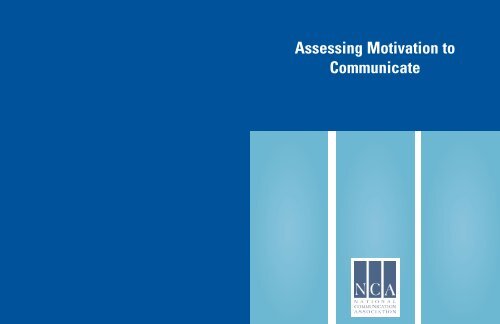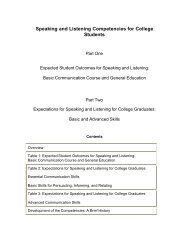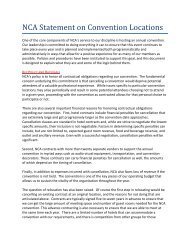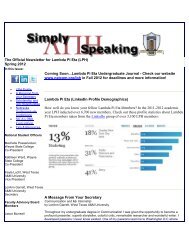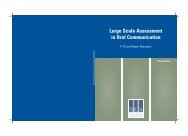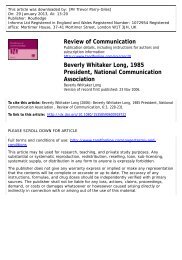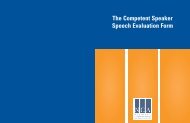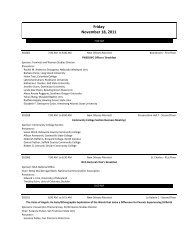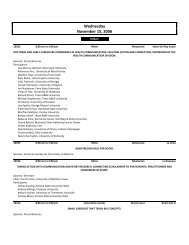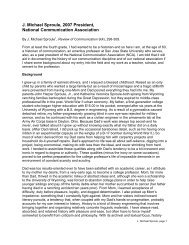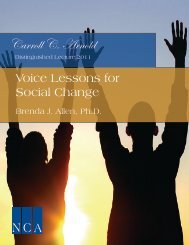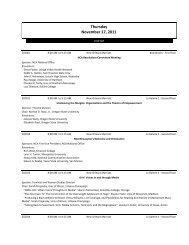Assessing Motivation to Communicate - National Communication ...
Assessing Motivation to Communicate - National Communication ...
Assessing Motivation to Communicate - National Communication ...
- No tags were found...
You also want an ePaper? Increase the reach of your titles
YUMPU automatically turns print PDFs into web optimized ePapers that Google loves.
<strong>Assessing</strong> <strong>Motivation</strong> <strong>to</strong><strong>Communicate</strong>
<strong>Assessing</strong> <strong>Motivation</strong> <strong>to</strong><strong>Communicate</strong>:Willingness <strong>to</strong> <strong>Communicate</strong>and Personal Report of<strong>Communication</strong> Apprehension2 nd EditionEdited By Sherwyn P. MorrealeUniversity of Colorado at Colorado Springs
All NCA Publication Program materials are reviewed within the spirit of academic freedom, promoting the free exchangeof ideas. The contents of this publication are the responsibility of its authors and do not necessarily reflect the officialpolicies or positions of the <strong>National</strong> <strong>Communication</strong> Association, its members, its officers, or its staff.© 2007 <strong>National</strong> <strong>Communication</strong> Association. All rights reserved.Brief portions of this publication may be copied and quoted without further permission with the understandingthat appropriate citations of the source will accompany any excerpts. A limited number of copiesof brief excerpts may be made for scholarly or classroom use if:• the materials are distributed without charge or no fees above the actual duplication costs arecharged;• the materials are reproductions, pho<strong>to</strong>copies, or copies made by similar processes, and not reprintsor republications;• the copies are used within a reasonable time after reproduction;• the materials include the full bibliographic citation; and• the following is also clearly displayed on all copies: "Copyright by the <strong>National</strong> <strong>Communication</strong>Association Reproduced by permission of the publisher."This permission does not extend <strong>to</strong> situations in which extensive amounts of material are reproduced ors<strong>to</strong>red in an electronic or similar data retrieval system, a fee above actual duplicating costs is chargedor if there exists a reasonable expectation of profit, or the material is reproduced or reprinted for otherthan scholarly or educational purposes.In such cases, permission must be obtained prior <strong>to</strong> reproduction and generally a reasonable fee will beassessed. Requests for permission <strong>to</strong> reproduce should be addressed <strong>to</strong> the Publications Manager.<strong>National</strong> <strong>Communication</strong> Association1765 N Street, NWWashing<strong>to</strong>n, D.C., 20036Library of Congress Catalog Card Number:ISBN: 0-944811-13-2
<strong>Assessing</strong> <strong>Motivation</strong> <strong>to</strong> <strong>Communicate</strong>:Willingness <strong>to</strong> <strong>Communicate</strong> andPersonal Report of <strong>Communication</strong> ApprehensionThis program includes two standardized and tested instruments <strong>to</strong> be used in assessing motivation <strong>to</strong> communicate at thehigher education level. The instruments were developed and tested by James McCroskey and are included in this program alongwith reference materials <strong>to</strong> inform their use. This program and the instruments it contains may be used: (a) <strong>to</strong> assess two dimensionsof the motivational domain of students; (b) for testing-in or testing-out (placement) purposes; (c) as a <strong>to</strong>ol for instructingand advising students; and (d) <strong>to</strong> generate assessment data for departmental or institutional accountability.The author/edi<strong>to</strong>r acknowledges the contributions <strong>to</strong> this program of James McCroskey, who developed the instrumentscontained here, as well as the efforts of many communication scholars who tested and used these instruments over many years.The efforts on the annotated bibliography of research assistant, Robert Hrdlickha, are also gratefully acknowledged. The technologicalsupport of Shawn Morgan of the University of Colorado at Colorado Springs provided the electronic versions of thetwo instruments that are included with this manual. Philip Backlund of Central Washing<strong>to</strong>n University, in his role as chair of theNCA Assessment Division, both encouraged and supported the development of this second edition.NCA Non-Serial Publication SeriesGust Yep, Edi<strong>to</strong>rSan Francisco State UniversityThe NCA Non-serial Publications (NSP) Program publishes book-length projects focusing on theoretical and/or pedagogicalissues related <strong>to</strong> the study and practice of human communication in a variety of contexts. Projects grounded in social scientific,interpretive, critical, performance, and rhe<strong>to</strong>rical approaches and methodologies are included. Diverse views of communicationranging from microscopic (e.g., social cognition, affect and emotion in communication) <strong>to</strong> macroscopic (e.g., public discourse,systems of representation) are also included. Topics that have been central <strong>to</strong> the his<strong>to</strong>ry of the discipline as well as those thathave been marginalized and excluded in the discipline are included as are projects with an inclusive, interdisciplinary, and socialjustice agenda.
Table of ContentsI. BACKGROUND . . . . . . . . . . . . . . . . . . . . . . . . . . . . . . . . . . . . . . . . . . . . . . . . . . . . . . . . . . . 7• What is motivation as an important part of communication competence? . . . . . . . . . . . . . . . 7• How can motivation be measured? . . . . . . . . . . . . . . . . . . . . . . . . . . . . . . . . . . . . . . . . . . . . . 7• What is “communication apprehension?” . . . . . . . . . . . . . . . . . . . . . . . . . . . . . . . . . . . . . . . 7• What is “willingness <strong>to</strong> communicate?” . . . . . . . . . . . . . . . . . . . . . . . . . . . . . . . . . . . . . . . . . 7II. FACT SHEET ABOUT THIS PROGRAM . . . . . . . . . . . . . . . . . . . . . . . . . . . . . . . . . . . . . 8• Contents of the program and the two instruments . . . . . . . . . . . . . . . . . . . . . . . . . . . . . . . . . 8• His<strong>to</strong>ry and description of the program . . . . . . . . . . . . . . . . . . . . . . . . . . . . . . . . . . . . . . . . . 8• Recommendations for using the program . . . . . . . . . . . . . . . . . . . . . . . . . . . . . . . . . . . . . . . . 8III. THE TWO INSTRUMENTS . . . . . . . . . . . . . . . . . . . . . . . . . . . . . . . . . . . . . . . . . . . . . . . . 10• Personal Report of <strong>Communication</strong> Apprehension . . . . . . . . . . . . . . . . . . . . . . . . . . . . . . . 10• Willingness <strong>to</strong> <strong>Communicate</strong> . . . . . . . . . . . . . . . . . . . . . . . . . . . . . . . . . . . . . . . . . . . . . . . . 12IV. LOGISTICS AND ADMINISTRATION OF THE INSTRUMENTS . . . . . . . . . . . . . . . 14• Using Web-based instruments . . . . . . . . . . . . . . . . . . . . . . . . . . . . . . . . . . . . . . . . . . . . . . . 14• Providing background <strong>to</strong> students about the instruments . . . . . . . . . . . . . . . . . . . . . . . . . . . 14• Creating a “safe environment” for administration of the instruments . . . . . . . . . . . . . . . . . 14V. ANNOTATED BIBLIOGRAPHY OF RESEARCH ARTICLES . . . . . . . . . . . . . . . . . . 14VI. APPENDICES . . . . . . . . . . . . . . . . . . . . . . . . . . . . . . . . . . . . . . . . . . . . . . . . . . . . . . . . . . . . 24• NCA Criteria for the Assessment of Oral <strong>Communication</strong> . . . . . . . . . . . . . . . . . . . . . . . . . 24• About the author of the instruments and the edi<strong>to</strong>rs of this program . . . . . . . . . . . . . . . . . . 28<strong>Assessing</strong> <strong>Motivation</strong> <strong>to</strong> <strong>Communicate</strong> v
I. BACKGROUNDThis program contains two self-report instruments,both of which assess the motivational domain of communication,also referred <strong>to</strong> as the attitudinal or affectivedomain. In using either of these instruments, it ishelpful <strong>to</strong> understand the important role of motivationin the overall process of communicating competently.What is motivation as an important part ofcommunication competence?<strong>Communication</strong> is competent, which means of highquality, when it is both appropriate and effective forthe particular situation (Morreale, Spitzberg, & Barge,2006). Appropriate communication means that you actin ways suitable <strong>to</strong> the norms and expectations of thecontext and situation in which you find yourself. Effectivecommunication means you are able <strong>to</strong> achievethe most desirable objectives or outcomes in the context.In order <strong>to</strong> communicate competently, there are threebasic requirements you must meet. First, you must bemotivated <strong>to</strong> communicate competently. Second, youmust be knowledgeable about the situation in whichyou are communicating and the kind of communicationexpected and needed in that situation. Third, you mustbe skilled at actually sending and receiving messages inthat particular situation. These three requirements or dimensionsof competence – motivation, knowledge, andskills – are the foundation of competent communicationwhether you are in an interpersonal situation, a group,public speaking, or even in a mass communication contextsuch as on television or in a mediated context likeusing e-mail.How can motivation be measured?The motivation requirement/dimension of competentcommunication suggests that you first must want<strong>to</strong> communicate. <strong>Motivation</strong> has both a positive sideand a negative side. Negative motivation is the experienceof anxiety or apprehension about communication,and it discourages you from communicating competently.Positive motivation is based on the perceptionor expectation of some kind of potential reward fromcommunicating and it encourages you <strong>to</strong> communicatecompetently.According <strong>to</strong> NCA’s Criteria for Assessment Instruments,the method of assessment should be consistentwith the dimension of oral communication being assessed.Knowledge and attitudes/motivation may be assessedthrough paper and pencil instruments, but speakingand listening skills must be assessed through actualperformance in social settings. The two instruments inthis program are paper and pencil assessment instruments,also referred <strong>to</strong> as self-report <strong>to</strong>ols. The PersonalReport of <strong>Communication</strong> Apprehension focuses on assessingthe negative side of motivation and the Willingness<strong>to</strong> <strong>Communicate</strong> focuses on assessing the positiveside of motivation.What is “communication apprehension?”The most common type of negative motivation iscalled communication apprehension – the fear or anxietyan individual experiences as a result of either realor anticipated communication with another person orpersons (Beatty, McCroskey, & Keisel, 1998). Indica<strong>to</strong>rsof this apprehension may be a nervous feeling inyour s<strong>to</strong>mach, shaky hands, talking <strong>to</strong>o fast or not talkingat all.Some people experience communication apprehensionwhenever they communicate. But most peopleonly get nervous about communicating in one or twocontexts but not in others. This context apprehensionabout communicating in a particular situation couldoccur interpersonally, in groups, or when speaking inpublic. One of the most common forms of context apprehensionis public speaking anxiety – a person’s fearor anxiety associated with a real or anticipated publicspeaking event.What is “willingness <strong>to</strong> communicate?”Positive motivation is often demonstrated by a person’swillingness <strong>to</strong> communicate – the individual’stendency <strong>to</strong> initiate communication. Indica<strong>to</strong>rs of thiswillingness may be approaching a stranger at a partyand introducing yourself, making the first suggestionin a group meeting, or raising your hand with a questionin a public lecture. Like apprehension, some peopleare willing <strong>to</strong> communicate in all contexts, while otherpeople are only willing <strong>to</strong> communicate in certain situationsor contexts and not others. For example, you maybe willing <strong>to</strong> communicate interpersonally or in smallgroups but not willing <strong>to</strong> initiate communicate aboutgiving a speech.<strong>Assessing</strong> <strong>Motivation</strong> <strong>to</strong> <strong>Communicate</strong> 7
Sources:Beatty, M.J., McCroskey, J.C., & Heisel, A.D. (1998) <strong>Communication</strong>apprehension as temperamental expression:A communibiological paradigm. <strong>Communication</strong> Monographs,65, 197-219.Morreale, S., Spitzberg, B., & Barge, K. (2006). Human communication:<strong>Motivation</strong>, knowledge, and skills. Belmont,CA: Thomson Wadsworth.II. FACT SHEET ABOUT THIS PROGRAMContents of the program and twoinstrumentsThis program contains two assessment instruments,the Personal Report of <strong>Communication</strong> Apprehension(PRCA) and the Willingness <strong>to</strong> <strong>Communicate</strong> (WTC).The instruments are presented in hard copy in this manualand on a Web site: http://www.uccs.edu/~webdept/excel/comm_prepost/index.php. As the descriptions ofthe two instruments below indicate, both are highly reliableand valid for measuring two dimensions of themotivational domain of communication competence.Personal Report of <strong>Communication</strong>Apprehension (PRCA-24)The PRCA-24 is the instrument that is most widelyused <strong>to</strong> measure communication apprehension. It ispreferable above all earlier versions of the instrument(PRCA, PRCA10, PRCA-24B, etc.). It is highly reliable(alpha regularly >.90) and has very high predictivevalidity. It permits one <strong>to</strong> obtain sub-scores onthe contexts of public speaking, dyadic interaction,small groups, and large groups. However, these scoresare substantially less reliable than the <strong>to</strong>tal PRCA-24scores because of the reduced number of items. Peopleinterested only in public speaking anxiety should considerusing the PRPSA rather than the public speakingsub-score drawn from the PRCA-24. It is much morereliable for this purpose.Willingness <strong>to</strong> <strong>Communicate</strong> (WTC)Willingness <strong>to</strong> communicate is the most basic orientation<strong>to</strong>ward communication. Almost anyone is likely<strong>to</strong> respond <strong>to</strong> a direct question, but many will not continuethe conversation or actually initiate an interaction.This instrument measures a person’s willingness <strong>to</strong> initiatecommunication. The face validity of the instrumentis strong, and results of extensive research indicate thepredictive validity of the instrument. Alpha reliabilityestimates for this instrument have ranged from .85 <strong>to</strong>well above .90. Of the 20 items on the instrument, 8 areused <strong>to</strong> distract attention from the scored items. The 12remaining items generate a <strong>to</strong>tal score, four context-typescores, and three receiver-type scores. The sub-scoresgenerate lower reliability estimates, but generally highenough <strong>to</strong> be used in research studies.His<strong>to</strong>ry and description of this programThis program, <strong>Assessing</strong> <strong>Motivation</strong> <strong>to</strong> <strong>Communicate</strong>,has been available through the <strong>National</strong> <strong>Communication</strong>Association for over 15 years. In its original form,the purchaser received hard copies of the instrumentsand a packet of articles describing the two instrumentsand their use in research and pedagogy. In this secondedition, the instruments are provided on a Web site <strong>to</strong>facilitate ease of administration; and, relevant researcharticles are provided in annotated form so the administra<strong>to</strong>rhas easy access <strong>to</strong> any needed background informationabout the instruments. While these instrumentsare available in the public domain, the second editionof this program is intended <strong>to</strong> provide everything, all inone place, that any administra<strong>to</strong>r or instruc<strong>to</strong>r needs <strong>to</strong>use these <strong>to</strong>ols effortlessly.Recommendations for using the programThis program and the instruments it contains may beused for several purposes.(a) Given the importance of motivation as a par<strong>to</strong>f communication competence, these instrumentsmay be used <strong>to</strong> assess two dimensions ofthe motivational domain of students – negative(PRCA) and positive motivation (WTC). Eitheror both instruments could be administered at thebeginning of a course <strong>to</strong> ascertain students’ levelof motivation; or, at the beginning and end of acourse as a pre-post test comparison.(b) Either or both instruments may be used for testing-inor testing-out (placement) purposes. For example,students with high levels of apprehension or8 <strong>Assessing</strong> <strong>Motivation</strong> <strong>to</strong> <strong>Communicate</strong>
low levels of willingness <strong>to</strong> communicate may needremedial training or courses. Conversely, studentswith low levels of apprehension and high levelsof willingness <strong>to</strong> communicate might be placed inmore advanced training situations or courses.(c) Either or both instruments may be used as a <strong>to</strong>olfor instructing and advising students regardingthe importance of the motivational domain ofcommunication. The students would be administeredthe instruments, followed by a discussion oftheir scores by comparison <strong>to</strong> the national normsfor each instrument.(d) Either or both instruments could be used <strong>to</strong> generateassessment data for departmental or institutionalaccountability. The instruments couldbe administered <strong>to</strong> all students on a campus, forexample, as part of a general education assessmentprogram.<strong>Assessing</strong> <strong>Motivation</strong> <strong>to</strong> <strong>Communicate</strong> 9
Personal Report of <strong>Communication</strong> Apprehension (PRCA-24)Directions: This instrument is composed of 24 statements concerning feelings about communicating with others.Please indicate the degree <strong>to</strong> which each statement applies <strong>to</strong> you by marking whether you:Strongly Disagree = 1; Disagree = 2; are Neutral = 3; Agree = 4; Strongly Agree = 5_____ 1. I dislike participating in group discussions._____ 2. Generally, I am comfortable while participating in group discussions._____ 3. I am tense and nervous while participating in group discussions._____ 4. I like <strong>to</strong> get involved in group discussions._____ 5. Engaging in a group discussion with new people makes me tense and nervous._____ 6. I am calm and relaxed while participating in group discussions._____ 7. Generally, I am nervous when I have <strong>to</strong> participate in a meeting._____ 8. Usually, I am comfortable when I have <strong>to</strong> participate in a meeting._____ 9. I am very calm and relaxed when I am called upon <strong>to</strong> express an opinion at a meeting._____10. I am afraid <strong>to</strong> express myself at meetings._____11. Communicating at meetings usually makes me uncomfortable._____12. I am very relaxed when answering questions at a meeting._____13. While participating in a conversation with a new acquaintance, I feel very nervous._____14. I have no fear of speaking up in conversations._____15. Ordinarily I am very tense and nervous in conversations._____16. Ordinarily I am very calm and relaxed in conversations._____17. While conversing with a new acquaintance, I feel very relaxed._____18. I’m afraid <strong>to</strong> speak up in conversations._____19. I have no fear of giving a speech._____20. Certain parts of my body feel very tense and rigid while giving a speech._____21. I feel relaxed while giving a speech._____22. My thoughts become confused and jumbled when I am giving a speech._____23. I face the prospect of giving a speech with confidence._____24. While giving a speech, I get so nervous I forget facts I really know.SCORING:Group discussion: 18 - (scores for items 2, 4, & 6) + (scores for items 1,3, & 5)Meetings: 18 - (scores for items 8, 9, & 12) + (scores for items 7, 10, & 11)Interpersonal: 18 - (scores for items 14, 16, & 17) + (scores for items 13, 15, & 18)Public Speaking: 18 - (scores for items 19, 21, & 23) + (scores for items 20, 22, &24)10 <strong>Assessing</strong> <strong>Motivation</strong> <strong>to</strong> <strong>Communicate</strong>
Group Discussion Score: _______Interpersonal Score: _______Meetings Score: _______Public Speaking Score: _______To obtain your <strong>to</strong>tal score for the PRCA, simply add your sub-scores <strong>to</strong>gether. _______Scores can range from 24-120. Scores below 51 represent people who have very low CA. Scores between 51-80represent people with average CA. Scores above 80 represent people who have high levels of trait CA.NORMS FOR THE PRCA-24: (based on over 40,000 college students; data from over 3,000 non-student adultsin a national sample provided virtually identical norms, within 0.20 for all scores.)Mean Standard Deviation High LowTotal Score: 65.6 15.3 > 80 < 51Group: 15.4 4.8 > 20 < 11Meeting: 16.4 4.2 > 20 < 13Dyad (Interpersonal): 14.2 3.9 > 18 < 11Public: 19.3 5.1 > 24 < 14Source:McCroskey, J. C. (2005). An introduction <strong>to</strong> rhe<strong>to</strong>rical communication (9 th ed). Englewood Cliffs, NJ: Prentice Hall.<strong>Assessing</strong> <strong>Motivation</strong> <strong>to</strong> <strong>Communicate</strong> 11
Willingness <strong>to</strong> <strong>Communicate</strong> (WTC)Directions: Below are 20 situations in which a person might choose <strong>to</strong> communicate or not <strong>to</strong> communicate. Presumeyou have completely free choice. Indicate the percentage of times you would choose <strong>to</strong> communicate in eachtype of situation. Indicate in the space at the left of the item what percent of the time you would choose <strong>to</strong> communicate.(0 = Never <strong>to</strong> 100 = Always)_____ 1. Talk with a service station attendant._____ 2. Talk with a physician._____ 3. Present a talk <strong>to</strong> a group of strangers._____ 4. Talk with an acquaintance while standing in line._____ 5. Talk with a salesperson in a s<strong>to</strong>re._____ 6. Talk in a large meeting of friends._____ 7. Talk with a police officer._____ 8. Talk in a small group of strangers._____ 9. Talk with a friend while standing in line._____10. Talk with a waiter/waitress in a restaurant._____11. Talk in a large meeting of acquaintances._____12. Talk with a stranger while standing in line._____13. Talk with a secretary._____14. Present a talk <strong>to</strong> a group of friends._____15. Talk in a small group of acquaintances._____16. Talk with a garbage collec<strong>to</strong>r._____17. Talk in a large meeting of strangers._____18. Talk with a spouse (or girl/boyfriend)._____19. Talk in a small group of friends._____20. Present a talk <strong>to</strong> a group of acquaintances.Scoring:Context-type sub-scores--Group Discussion: Add scores for items 8, 15, & 19; then divide by 3.Meetings: Add scores for items 6, 11, 17; then divide by 3.Interpersonal: Add scores for items 4, 9, 12; then divide by 3.Public Speaking: Add scores for items 3, 14, 20; then divide by 3.Receiver-type sub-scores--Stranger: Add scores for items 3, 8, 12, 17; then divide by 4.Acquaintance: Add scores for items 4, 11, 15, 20; then divide by 4.12 <strong>Assessing</strong> <strong>Motivation</strong> <strong>to</strong> <strong>Communicate</strong>
Friend: Add scores for items 6, 9, 14, 19; then divide by 4.To compute the <strong>to</strong>tal WTC score, add the sub scores for stranger, acquaintance, and friend. Then divide by 3.All scores, <strong>to</strong>tal and sub-scores, will fall in the range of 0 <strong>to</strong> 100Norms for WTC Scores:Group discussion >89 High WTC, 80 High WTC, 94 High WTC, 78 High WTC, 63 High WTC, 92 High WTC, 99 High WTC, 82 High Overall WTC,
IV. LOGISTICS AND ADMINISTRATION OF THE INSTRUMENTSUsing Web-based instrumentsElectronic versions of the Personal Report of <strong>Communication</strong>Apprehension (PRCA-24) and the Willingness<strong>to</strong> <strong>Communicate</strong> (WTC) and a software program thatau<strong>to</strong>matically scores each of the instruments are availableon the Internet at http://www.uccs.edu/~webdept/excel/comm_prepost/index.php. To administer the instruments,send respondents <strong>to</strong> take the instrumentsonline <strong>to</strong> this website. Users will type in their e-mailaddress and name and then click “login” (Don’t worryabout the class — only one can be chosen — “<strong>Assessing</strong><strong>Motivation</strong> <strong>to</strong> <strong>Communicate</strong>”). This will take users<strong>to</strong> the page where they can choose <strong>to</strong> take a test (one oftwo). As soon as the respondent completes each instrument,the program scores and presents the results. Theresults may be printed out and retained for data analysispurposes by the test administra<strong>to</strong>r. A link at the bot<strong>to</strong>mallows the user <strong>to</strong> return <strong>to</strong> the “index” (choice oftests page) where they can then take the other test. Thebackend s<strong>to</strong>res the data based on email address andname. Each respondent must use a unique e-mail address.Individual item scores, group scores, and <strong>to</strong>talswill be downloaded <strong>to</strong> an Excel file that will be housedon a server at the University of Colorado at ColoradoSprings (UCCS). Should the test administra<strong>to</strong>r requireindividual items scores, please send an e-mail request<strong>to</strong> Shawn Morgan (smorgan2@uccs.edu), instruc<strong>to</strong>rat UCCS and the system administra<strong>to</strong>r. The requestshould include all of the e-mail addresses from eachrespondent.Providing background <strong>to</strong> students aboutthe instrumentsBefore administering the instruments <strong>to</strong> students, use theinformation in the BACKGROUND and FACT SHEETsections of this program <strong>to</strong> explain what the instrumentsassess and why it is important <strong>to</strong> learn about one’s ownmotivation <strong>to</strong> communicate. Include definitions and descriptionsof: communication competence as motivation,knowledge, and skills; communication apprehension (andpublic speaking anxiety if the students are taking a publicspeaking course); and willingness <strong>to</strong> communicate.Creating a “safe environment” for administrationof the instrumentsWhen administering these two instruments, it iscritical <strong>to</strong> create a safe and supportive environment inwhich the students fill out the instruments and learntheir scores. Given that some students may score high incommunication apprehension or low in willingness <strong>to</strong>communicate, it is necessary that scores be confidentialbetween the administra<strong>to</strong>r and the student. In addition,students should be advised that there is not a right orwrong score; rather, the scores are diagnostic and serve<strong>to</strong> highlight aspects of communication motivation thatmay need some attention and development.V. ANNOTATED BIBLIOGRAPHY OF RESEARCH ARTICLESThe two assessment instruments contained in thisprogram have been used extensively for years by communicationscholars as well as researchers from manyother academic disciplines. The following academic articlesare annotated here in order <strong>to</strong> provide the readerwith some sense of how the instruments have provenuseful <strong>to</strong> others. The articles are categorized chronologicallywithin three categories. Studies that used thePersonal Report of <strong>Communication</strong> Apprehension arepresented first, then those that used the Willingness <strong>to</strong><strong>Communicate</strong>, and then studies that made use of bothinstruments. Some of the annotated articles used the instrumentsin research studies while others focus on thedevelopment and testing of the psychometric propertiesof the instruments. The annotations are immediatelyfollowed by a copy of the <strong>National</strong> <strong>Communication</strong>Association’s official guidelines and criteria for the assessmen<strong>to</strong>f oral communication.Personal Report of <strong>Communication</strong>Apprehension (PRCA)McCroskey, J., Beatty, M., Kearney, P. & Plax, T. (1985).The content validity of the PRCA-24 as a measure ofcommunication apprehension across communicationcontexts. <strong>Communication</strong> Quarterly, 33(3).14 <strong>Assessing</strong> <strong>Motivation</strong> <strong>to</strong> <strong>Communicate</strong>
Research reported by Porter (1981) and Parks (1980)has raised significant reservations concerning the contentvalidity of the items on the early versions of thePRCA. The present study investigated the contentvalidity of the most recent version of the instrument,PRCA-24. The results of this research indicate that thescores generated by the new instrument are relativelyindependent of the context-based content of the itemsemployed and are capable of substantially predictingapprehension in a context not represented directly in theitems on the new form.Loffredo, D. & Opt, S. (2000). Rethinking communicationapprehension: A Myers-Briggs perspective.Journal of Psychology, 134(5), 556.This study is an examination of relationships betweenMyers-Briggs personality type preferences,based on Jungian theory, and communication apprehension.Results showed that participants who preferredintroversion or sensing reported significantlyhigher levels of communication apprehension ingeneral and across the group, dyadic, meeting, andpublic contexts than did participants who preferredextraversion or intuition. In addition, participants whopreferred feeling reported higher levels of communicationanxiety in the public context than those whopreferred thinking. Findings support the assumptionthat communication apprehension is biologicallybased; suggest that the Myers-Briggs type preferenceframework offers an alternative way of understandingcommunication apprehension; and, point out the needfor new approaches <strong>to</strong> understanding the phenomenonof communication apprehension.Wright, K. (2000). Social support satisfaction onlinecommunication apprehension and perceived lifestress within computer-mediated support groups.<strong>Communication</strong> Research Reports, 17(2), 139-147.This study used an on-line questionnaire <strong>to</strong> examinethe relationship between social support satisfaction, onlinecommunication time, online communication apprehension,and perceived life stress among membersof various online support groups (N = 140). The resultsindicated that online support satisfaction was predictiveof online communication time while online communicationapprehension was not related <strong>to</strong> online communicationtime. Online communication apprehension wasfound <strong>to</strong> be predictive of online support satisfaction.Online support satisfaction was found <strong>to</strong> be predictiveof perceived life stress. The implications of findings forcommunication and social support research as well asthe limitations of the study are discussed.Burk, J. (2001). <strong>Communication</strong> apprehension amongmaster’s of business administration students: Investigatinga gap in communication education. <strong>Communication</strong>Education, 50(1), 51-58.Master’s of Business Administration students at alarge Midwestern university were administered thePersonal Report of <strong>Communication</strong> Apprehension-24. The students also responded <strong>to</strong> a questionnairethat generated data for six independent variables andwere analyzed in relation <strong>to</strong> the PRCA-24 scores via amultiple regression analysis. The findings indicate thatcommunication apprehension (CA) exists among theMBA students with the average overall score slightlybelow national average. The students had low dyadic,but high meeting and public speaking apprehension.Undergraduate major and culture significantly predictedthe PRCA-24 scores. Students with math-relatedmajors had significantly lower CA than studentswith business-related or other undergraduate majors.The findings suggest that MBA programs are not addressingCA in their curricula.Campbell, S. & Neer, M. (2001). The relationship ofcommunication apprehension and interaction involvement<strong>to</strong> perceptions of computer-mediatedcommunication. <strong>Communication</strong> Research Reports,18(4), 391-398.This study investigated how the interpersonal traitsof communication apprehension (CA) and interactioninvolvement (II) are related <strong>to</strong> one’s attitudes <strong>to</strong>wardand use of computer-mediated communication (CMC).Data were collected by administering a self-report survey<strong>to</strong> a sample of 133 participants, and results wereanalyzed with multiple regression. Findings revealedthat CA and II failed <strong>to</strong> predict CMC attitudes. However,each trait predicted communication style duringonline interaction. Findings are interpreted within thecontext of current theories of CMC.Jones-Corley, J. & Messman, S. (2001). Effects of communicationenvironment, immediacy, and communicationapprehension on cognitive and affective learning.<strong>Communication</strong> Monographs, 68(2), 391-398.This study explores relationships among immediacy,communication apprehension, and learning outcomesbetween two class formats: mixed-size sections (i.e.,<strong>Assessing</strong> <strong>Motivation</strong> <strong>to</strong> <strong>Communicate</strong> 15
large-lecture/break-out sections) versus self-containedsections. The results indicated that students’ cognitivelearning outcomes were slightly greater in the mixed-sizesections versus self-contained sections. In addition, affectivelearning decreased for all students from the first dayof class, though it decreased slightly more for studentsin the large-lecture/break-out sections. When the teacherwas perceived as highly immediate, however, there wasno difference in affective learning due <strong>to</strong> format.Toale, M. (2001). Ethnocentrism and trait communicationapprehension as predic<strong>to</strong>rs of interethnic communicationapprehension and use of relational maintenancestrategies in interethnic communication.<strong>Communication</strong> Quarterly, 49(1), 70-83.The first of two studies investigated the differences betweenreported relational maintenance strategy usage byhigh and low interethnic communication apprehensives(IECAs). An instrument based on Canary and Stafford’s(1992) relational maintenance strategies taxonomy andNeuliep and McCroskey’s (1997a) Personal Report ofInterethnic <strong>Communication</strong> Apprehension (PRECA)was employed. The results indicated that individuals whowere low IECAs reported utilizing significantly more ofthe task, network, and positivity strategies.Differences in openness and assurance strategies followedthe same pattern but were not significant. Theparticipant’s reported usage and IECA score were inverselyrelated. The second study replicated the firstand explored two theoretical explanations for the results.This study revealed significant differences on allof the dimensions and significant negative correlations.This study also examined whether trait communicationapprehension {disregarding ethnicity) and/or ethnocentrismthe presumed foundational components of IECA)could account for the differences in reports of relationalcommunication behavior. The results of the secondstudy indicated that both trait CA and ethnocentrismcontributed <strong>to</strong> the prediction of IECA and <strong>to</strong> overall reportedstrategy usage, and that ethnocentrism was thebetter predic<strong>to</strong>r.Behnke, R & Sawyer, C. (2002). Reduction in publicspeaking state anxiety during performance as afunction of sensitization processes. <strong>Communication</strong>Quarterly, 50(1), 112-121.Recently, scholars have suggested that biologicalfac<strong>to</strong>rs, such as temperament, influence human socialbehavior, particularly in the formation of traits, such ascommunication apprehension. Despite progress in thisarea, the relationship between temperament and states,such as speech anxiety, remains unclear. Theories oftemperament predict that the rate at which subjectshabituate <strong>to</strong> stress varies inversely with the degree <strong>to</strong>which they are sensitized during initial confrontationwith stress-producing stimuli. The inverse relationshipbetween habituation and sensitization, in the context ofpublic speaking state anxiety, is examined in this report.In two separate studies, using both physiological andpsychological measures of state anxiety, the inverserelationship between sensitization and habituation wasconfirmed. Specifically, sensitization accounted for69.1% and 50.3% of the variance in physiological andpsychological habituation, respectively.Bline, D., Lowe, D., Meixner, W., & Nouri, H. (2003).Measurement data on commonly used scales <strong>to</strong> measureoral communication and writing apprehensions.Journal of Business communication, 40(4), 266-288.Curriculum changes and training advances in businesscommunication have provided students and practitionerswith an opportunity <strong>to</strong> develop and improvecommunication skills. Despite such changes, researchcontinues <strong>to</strong> demonstrate that communication apprehensioncan injuriously impede skills attainment. Yet,the measurement properties of instruments used <strong>to</strong> measureoral and writing apprehension have received limitedattention. In particular, research has not fully exploredthe impact of question order on the measurementproperties of these instruments. This article presents theresults of an investigation about the effect of questionorder randomization on the psychometric properties oftwo frequently used oral and written apprehension instruments.Results showed that the measurement propertiesof these instruments were significantly alteredwhen the question order was randomized.Bodie, G. & Villaume, W. (2003). Aspects of receivinginformation: The relationship between listeningpreferences, communication apprehension,receiver apprehension, and communica<strong>to</strong>r style.International Journal of Listening, 17, 47-57.This study investigated connections between listeningpreferences and patterns of communica<strong>to</strong>r style andapprehension. An initial discriminant analysis was conducted<strong>to</strong> test whether six categories of listening stylesare systematically discriminated by communica<strong>to</strong>r style,communication apprehension, and receiver apprehension.There was one significant discriminant function,whose interpretation was somewhat questionable. Sub-16 <strong>Assessing</strong> <strong>Motivation</strong> <strong>to</strong> <strong>Communicate</strong>
sequently, a canonical correlation was conducted <strong>to</strong> testif four interval level listening preferences are systematicallyrelated <strong>to</strong> communica<strong>to</strong>r style, communicationapprehension, and receiver apprehension. The resultswere highly significant and identified three patterns ofassociation between the set of listening preferencesand the set of communica<strong>to</strong>r style and apprehensionvariables. One: High people-orientation in listening issystematically associated with lower receiver apprehensionand dyadic communication apprehension andwith a more relationally oriented communication stylethat attends <strong>to</strong> and affirms the other person. Two: Thecombination of high content- and action-orientations isassociated with a precise and attentive style of arguingthe issues that leaves a strong impression on other people.Three: The configuration of high time- and actionorientationsalong with a lack of content-orientation isassociated with higher receiver apprehension but lowerdyadic communication apprehension, and also with adramatic, animated and forceful style that asserts one’sgoals/concerns and tends <strong>to</strong> dominate the other person.Cole, J. & McCroskey, J. (2003). The association of perceivedcommunication apprehension, shyness, andverbal aggression with perceptions of source credibilityand affect in organizational and interpersonalcontexts. <strong>Communication</strong> Quarterly, 51(1), 101-110.This is a report of two studies that examined the associationof receivers’ perceptions of sources’ levels ofseveral communication traits (shyness, communicationapprehension, verbal aggressiveness) with the receivers’reported levels of affect for the source (generalaffect and/or liking) and the receivers’ perceptions ofthe sources’ credibility (competence, trustworthiness,goodwill). Study 1 examined employees’ perceptionsof their supervisor’s communication trait behaviors inthe organizational context, while Study 2 examined thestudents’ perceptions of their roommate’s communicationtrait behaviors in an interpersonal context. As predictedon the basis of previous theory and research, bothperceived communication apprehension and perceivedverbal aggressiveness of the source were found <strong>to</strong> besubstantially negatively correlated with credibility andaffect and/ or liking reported by the receiver. Contrary<strong>to</strong> our hypothesis, perceived behavioral shyness was notmeaningfully associated with either credibility or affect.It is concluded that these results provide importantinformation for distinguishing between the theoreticalconstructs of shyness and communication apprehensionand theory in this area in general.Rancer, A., & Yang, L. (2003). Ethnocentrism, interculturalcommunication apprehension, interculturalwillingness-<strong>to</strong>-communicate, and intentions <strong>to</strong> participatein an intercultural dialogue program: Testinga proposed model. <strong>Communication</strong> Research Reports,20(2), 189-190.The article focuses on a model on ethnocentrism andintercultural communication apprehension, interculturalwillingness-<strong>to</strong>-communicate (IWTC) and intentions<strong>to</strong> participate in an intercultural dialogue program.Results of the study suggest that the proposed modelrefinement. The data suggest a modified model refinementwhich argues that ethnocentrism and interculturalcommunication apprehension are related. It also arguesthat ethnocentrism and intercultural communicationapprehension are both related <strong>to</strong> IWTC. Ethnocentrismand IWTC are related <strong>to</strong> intentions <strong>to</strong> participate in culturalexchange program. Thus IWTC is influenced byboth ethnocentrism and intercultural communicationapprehension. Both ethnocentrism and IWTC have adirect influence on individuals’ intentions <strong>to</strong> participatein intercultural dialogue program. The implication ofthis finding is that if one wants <strong>to</strong> get an estimate ofan individual’s intentions <strong>to</strong> participate in such programor other intercultural encounter, it would be prudent <strong>to</strong>measure ethnocentrism and IWTC.Bar<strong>to</strong>o, H. & Sias, P. (2004). When enough is <strong>to</strong>omuch: <strong>Communication</strong> apprehension and employeeinformation experiences. <strong>Communication</strong> Quarterly,52(1), 15-26.This study examines the relationships between supervisorcommunication apprehension, employee communicationapprehension, and employees’ reports ofinformation received from their supervisor. Results indicatedthat supervisor communication apprehensionwas negatively related <strong>to</strong> employees’ reports of informationreceived. Employee communication apprehensionand employees’ reports of information receivedfrom supervisors were not significantly related. Supervisorcommunication apprehension was negativelyrelated <strong>to</strong> the information load reported by employees.Finally, a positive relationship was identified betweenemployee communication apprehension and the informationload reported by employees.Hsu, C. (2004). Sources of differences in communicationapprehension between Chinese in Taiwan andAmericans. <strong>Communication</strong> Quarterly, 52(4), 370-389.<strong>Assessing</strong> <strong>Motivation</strong> <strong>to</strong> <strong>Communicate</strong> 17
This study investigated whether cross-cultural differencesin communication apprehension (CA) can be explainedwith regard <strong>to</strong> cultural orientations, personalitytraits and component theory. To this end, a <strong>to</strong>tal of 618undergraduates, studying in Taiwan (n = 298) and theUnited States (n = 320), participated in this study. Participantsfilled out the Personal Report of <strong>Communication</strong>Apprehension along with Self-Construal Scale, the RevisedNEO Personality Inven<strong>to</strong>ry, Fear of Negative Evaluation,and Self-Perceived <strong>Communication</strong> Competencescale. The results indicated that Chinese in Taiwan scoredsignificantly higher in communication apprehension thanAmericans. The influence of culture on CA was mediatedby independence self-construal, neuroticism, extroversion,fear of negative evaluation, and communicationcompetence. The strongest mediating effect was foundfor self-perception of communication competence. Theimplications of these findings were further discussed.Hye, Y. J. & McCroskey, J. (2004). <strong>Communication</strong>apprehension in a first language and self-perceivedcompetence as predic<strong>to</strong>rs of communication apprehensionin a second language: A study of speakers ofEnglish as a second language. <strong>Communication</strong> Quarterly,52(2), 170-181.This study addresses the communication apprehensionof the non-native English speaker in the U.S. Previousstudies which have examined the implications ofcommunication apprehension (CA) for bilingual, nonnativecommunica<strong>to</strong>rs have generated results whichindicate that trait-like CA is consistent across first andsecond language-speaking situations. However, noneof these studies have probed the cause of the cross-linguisticconsistency of CA. This research is designed<strong>to</strong> provide a scientific explanation for the etiology ofCA by applying the communibiological paradigm <strong>to</strong>CA theory and research. By selecting the situationalconstraints of international students, this study tests atheory based on proposition 4 of the communibiologicalparadigm (Beatty & McCroskey w/Valencia, 2001,p. 128): “Environment or situation’ has only a negligibleeffect on interpersonal behavior.’ The results ofthis study replicate the strong relationship previouslyobserved between CA in a first language and CA in asecond language. It also found that the genetic markersemployed (Eysenck’s Big 3 temperament variables)predicted first and second language CA approximatelyequally. The results indicate that, although both first andsecond languages are learned, the CA associated withthem most likely is not.McCroskey, J., Richmond, V., Johnson, A., & Smith, H.(2004). Organizational orientations theory and measurement:Development of measures and preliminaryinvestigations. <strong>Communication</strong> Quarterly, 52(1), 1-14.Four studies are reported which focus on organizationalorientations theory and relevant measuring instruments.An initial study designed <strong>to</strong> develop measuresof the three components believed <strong>to</strong> constituteorganizational orientation (upward mobile, indifferent,and ambivalent) is reported. Since it was believed thatvalid measures of organizational orientations should beassociated with the way workers communicate, a secondstudy designed <strong>to</strong> determine the association of organizationalorientations with communication apprehension,immediacy, assertiveness, responsiveness, andjob satisfaction was conducted as a preliminary validitytest. Results of the first two studies pointed <strong>to</strong> boththe reliability and the validity of the new measures. Athird study was conducted which included new itemsdesigned <strong>to</strong> increase the reliability of the scales. Theresults generated revised measures with higher reliability.The fourth study was designed <strong>to</strong> expand the validationof the instruments by testing their associationswith temperament, job satisfaction, and subordinates’perceptions of the credibility of their supervisors. Resultssuggest that the organizational orientations areassociated with the “BIG THREE” temperament variables(extraversion, neuroticism, psychoticism) and arepredictive of both job satisfaction and perceptions ofsupervisor credibility. Suggestions for future researchand the limitations of the research program at this pointare discussed.Lippert, L., Titsworth, B., & Hunt, S. (2005). The ecologyof academic risk: Relationships between communicationapprehension, verbal aggression, supportivecommunication, and students’ academic risk status.<strong>Communication</strong> Studies, 56 (1), 1-21.Contemporary research exploring at-risk studentpopulations has generally used the epidemiologicalmodel, the constructivist model, or the ecologicalmodel <strong>to</strong> explain processes involved in academic risk.This study applies communication constructs <strong>to</strong> theecological model of academic risk, which proposes thatacademic risk is a function of individual, social, andcultural communication phenomena. A survey of 232students found that (a) at-risk students communicatedmore with friends about school than did regular-admissionstudents, (b) levels of communication apprehen-18 <strong>Assessing</strong> <strong>Motivation</strong> <strong>to</strong> <strong>Communicate</strong>
sion differed depending on at-risk status and sex, and(c) levels of verbal aggression differed depending onat-risk status. These results are discussed in terms oftheoretical and applied implications.Scott, C. & Timmerman, E. (2005). Relating computer,communication, and computer-mediated communicationapprehension <strong>to</strong> new communication technologyused in the workplace. <strong>Communication</strong> Research,32(6), 683-725.This study explores three issues regarding the useof multiple workplace communication technologies:the relationships between distinct forms of apprehension(computer, communication, and writing) and use,the relative contribution of computer-mediated communication(CMC) apprehension for predicting use,and changes in these relationships over time. A trendstudy, which consisted of the collection of data fromtwo samples (N = 205) separated by a 5-year interval,suggests full or partial support for the hypotheses involvingcomputer and communication apprehension.Although apprehension levels remain stable, usage frequencychanged for several of the technologies examined—resultingin stronger relationships between apprehensionsand those technologies for which use haschanged the most in the past 5 years. Most notably, anew measure of CMC apprehension generally predictscommunication technology use—especially text-basedand conferencing <strong>to</strong>ols—more strongly than do moretraditional apprehension types.Zhang, Q. (2005). Teacher immediacy and classroomcommunication apprehension: A cross-cultural investigation.<strong>Communication</strong> Research, 34(1/2), 50-64.The present study investigates classroom communicationapprehension in relation <strong>to</strong> perceived teacherverbal and nonverbal immediacy in Chinese and U.S.college classrooms. The objectives of this study arethree-fold: <strong>to</strong> compare classroom communication apprehensionand perceived teacher verbal and nonverbalimmediacy, and <strong>to</strong> examine the impact of teacher immediacyon classroom communication apprehension inChinese and U.S. college classrooms. This study reportsthree major findings, including (a) Chinese studentshave a significantly higher classroom communicationapprehension than their U.S. counterparts, (b) Chinesestudent perceptions of teacher verbal immediacy aresignificantly higher than U.S. student perceptions, buttheir perceptions of teacher nonverbal immediacy arenot significantly different, and (c) classroom communicationapprehension is correlated negatively with USstudent perceptions of teacher nonverbal immediacy,but not with verbal immediacy; classroom communicationapprehension is not correlated negatively withChinese student perceptions of teacher verbal and nonverbalimmediacy.Zhang, Q. & Zhang J. (2005). Teacher clarity: Effectson classroom communication apprehension, studentmotivation, and learning Chinese college classrooms.<strong>Communication</strong> Research, 34(3/4), 255-266.Teacher clarity is central <strong>to</strong> overall teaching effectivenessand student learning. The purpose of this studyis <strong>to</strong> extend the line of research on teacher clarity fromU.S. classrooms <strong>to</strong> Chinese classrooms. Specifically, itinvestigates the effects of teacher clarity on classroomcommunication apprehension, student motivation,and affective and cognitive learning in Chinese collegeclassrooms. Pearson correlation suggests that teacherclarity is associated negatively with classroom communicationapprehension, but positively with studentmotivation <strong>to</strong> learn and affective and cognitive learningin Chinese classrooms.Willingness <strong>to</strong> <strong>Communicate</strong> (WTC)McCroskey, J.C. and Richmond, V.P. (1990) “Willingness<strong>to</strong> communicate: Differing cultural perspectives.”The Southern <strong>Communication</strong> Journal, 56(1).The general tendency <strong>to</strong> approach or avoid communicationhas been recognized as an important individualdifference among people in a single culture forseveral decades. Recent research in Australia, Micronesia,Puer<strong>to</strong> Rico, Sweden, and the United States suggestslarge differences exist in such tendencies betweenpeople in different cultures as well as within a givenculture. This research suggests “individual” tendenciesmay be developed <strong>to</strong> very different degrees in dissimilarcultures. The view is taken that an understanding ofthe cultural impact on individual differences should bea vital component in the study of intercultural communication.Examples are drawn from research on generalwillingness <strong>to</strong> communicate, introversion, communicationapprehension, and self-perceived communicationcompetence in several countries around the world.McCroskey, J.C. (1992). Reliability and validity of theWillingness <strong>to</strong> <strong>Communicate</strong> scale. <strong>Communication</strong>Quarterly, 40 (1).<strong>Assessing</strong> <strong>Motivation</strong> <strong>to</strong> <strong>Communicate</strong> 19
The nature and assumptions underlying the Willingness<strong>to</strong> <strong>Communicate</strong> (WTC) scale are outlined and discussed.Data are discussed which relate <strong>to</strong> the reliabilityand validity of the instrument. It is concluded that thescale is of sufficient quality <strong>to</strong> be recommended for researchand screening purposes.Kearne, P. & Waldeck, J., (2001). Teacher e-mail messagesstrategies and students’ willingness <strong>to</strong> communicateonline. Journal of Applied <strong>Communication</strong>Research, 29(1), 54.In light of the prevalent use of e-mail between teachersand students, researchers have highlighted the need <strong>to</strong>assess its uses and effects. Relying on the research andthinking of teacher immediacy and extra-class communication,we developed a scale that measures those e-mailmessage strategies that influence student’s willingness <strong>to</strong>communicate online with their teachers. Next, we isolatedthose reasons that students use e-mail <strong>to</strong> interactwith their teachers: (1) <strong>to</strong> clarify course material and procedures,(2) as a means of efficient communication, and(3) for personal/social reasons. Finally, we examined studentcharacteristics such as gender and ethnicity, and his<strong>to</strong>ryof e-mail use that may (or may not) influence theirattitudes <strong>to</strong>ward e-mail exchanges with teachers.Olaniran, B.& Roach, D. (2001). Intercultural willingness<strong>to</strong> communicate and communication anxiety ininternational teaching assistants. <strong>Communication</strong> ResearchReports, 18(1), 26-35.This study addressed patterns and correlates of communicationapprehension, intercultural communicationapprehension, and intercultural willingness <strong>to</strong> communicatein international teaching assistants. Results indicatedan inverse relationship between communicationapprehension of international TAs and their satisfactionwith students, relationship with students, and perceptionsof” student ratings of instruction. Similar resultswere found for ITA state anxiety. Inverse relationshipswere also found between ITA intercultural communicationapprehension and relationship with students andperceptions of student ratings of instruction. Internationalteaching assistant CA and ICA were positivelyrelated with ITA state anxiety.Miller, J., & Morgan, S. (2002). Beyond the organ donorcard: The effect of knowledge, attitudes, and valueson willingness <strong>to</strong> communicate about organ donation<strong>to</strong> family members. Health <strong>Communication</strong>, 14(1),121-134.Although numerous studies have examined many ofthe predic<strong>to</strong>rs of signing an organ donor card, includingknowledge, attitudes, values, and demographic variables,very few have examined the fac<strong>to</strong>rs associatedwith individuals’ willingness <strong>to</strong> communicate abou<strong>to</strong>rgan donation with family members. Because organdonation does not take place without the permission ofa person’s next-of-kin, government agencies and organprocurement organizations have targeted communicationwith family members as a primary objective of organdonation campaigns. This study reports the resultsof a survey of a stratified random sample of adults at 2local sites of a national employer. Results indicate thatknowledge, attitude, and altruism are significantly related<strong>to</strong> 2 measures of willingness <strong>to</strong> communicate: pastbehavior (whether respondents had already discussedorgan donation with family members) and a scale measuringwillingness <strong>to</strong> communicate about organ donationin the future. Because the quality of discussionsbetween the potential donor and his or her family willdepend on how well the donor is able <strong>to</strong> address vital issuesregarding donation, it is concluded that campaignsseeking <strong>to</strong> promote communication between familymembers about organ donation must simultaneouslyseek <strong>to</strong> increase knowledge, debunk myths, and bolsterpositive attitudes about donation.Yahima, T. (2002). Willingness <strong>to</strong> communicate in asecond language: The Japanese EFL context. ModernLanguage Journal, 86(1), 54.Willingness <strong>to</strong> communicate (WTC) is emerging asa concept <strong>to</strong> account for individuals’ first language (L1)and second language (L2) communication. This studyexamined relations among L2 learning and L2 communicationvariables in Japanese English as a foreign languagecontext using the WTC model and the socioeducationalmodel as a framework. A L2 communicationmodel was constructed and tested using AMOS version4.0, with a sample of 297 Japanese university students.In the model, a latent variable, international posture,was hypothesized <strong>to</strong> capture the general attitude <strong>to</strong>wardthe international community and foreign languagelearning in Japan. From structural equation modeling, itappeared that international posture influences motivation,which, in turn, influences proficiency in English.<strong>Motivation</strong> affected self-confidence in L2 communicationwhich led <strong>to</strong> willingness <strong>to</strong> communicate in a L2.In addition <strong>to</strong> this indirect path, a direct path from internationalposture <strong>to</strong> WTC in a L2 was significant. Themodel’s fitness <strong>to</strong> data was good, which indicates the20 <strong>Assessing</strong> <strong>Motivation</strong> <strong>to</strong> <strong>Communicate</strong>
potential for using the WTC and other constructs <strong>to</strong> accountfor L2 communication.Baker, S., Clement, R., Donavan, L., & MacIntyre, P.(2003). Sex and age effects on willingness <strong>to</strong> communicate,anxiety perceived competence, and L2motivation among junior high school French immersionstudents. Language Learning, 53, 137-166.The students who participate in immersion educationare an impressive group. In the present study we looked atstudents in a junior high school in Nova Scotia. In the localarea, English is far and away the dominant language,though there are French-speaking communities withina two-hour drive and Canada is an officially bilingualcountry. Therefore, the students are not in a “foreign”language-learning environment, but in all probability,they are not likely <strong>to</strong> encounter spoken French in theirdaily lives. The students have all the challenges of adolescence<strong>to</strong> contend with: moving from an elementary <strong>to</strong>a junior high school in grade 7, the wonders of puberty,growing academic expectations from teachers, demandsfrom school administration <strong>to</strong> speak only French while atschool, and the burgeoning social life of a newly mintedteenager. On <strong>to</strong>p of all this, participants in this researchare required <strong>to</strong> give up their well-developed native language,English, and undertake <strong>to</strong> be educated in a secondlanguage, French. Impressive. The present study reportsa cross-sectional investigation of second language communicationamong students in a junior high French lateimmersion program. The effects of language, sex, andgrade on willingness <strong>to</strong> communicate (WTC), anxiety,perceived communication competence, and frequencyof communication in French and on attitude/motivationvariables are examined globally and at each grade level.Most of these variables have been widely studied amongadult learners, most often at the university level. Thepresent study attempted <strong>to</strong> look at a much younger group<strong>to</strong> examine the patterns earlier in the language learningprocess. We found that students’ second language WTC,perceived competence, and frequency of communicationin French increased from grades 7 <strong>to</strong> 8 and that these increaseswere maintained between grades 8 and 9, despitea drop in motivation between grades 7 and 8 and a steadylevel of anxiety across the three grades. Gender differencesin language anxiety in grade 9. However, the differencesbetween WTC across the first and second languagenarrowed as students progressed through the program.Martin, M., Mottet T., & Myers, S. (2003). Relationshipsamong perceived instruc<strong>to</strong>r verbal approachand avoidance relational strategies and students’ motivesfor communicating with their instruc<strong>to</strong>rs. <strong>Communication</strong>Education, 53(1), 116-122.In light of a new “student engagement” benchmarkfor teaching and institutional effectiveness in highereducation, this study focused on the relationships betweenperceived instruc<strong>to</strong>r use of verbal approach andavoidance relational strategies and students’ motivesfor communicating with their instruc<strong>to</strong>rs. The data suggestthat perceived instruc<strong>to</strong>r use of verbal approachrelational strategies positively influences students’ motivation<strong>to</strong> engage with their instruc<strong>to</strong>rs for relational,participa<strong>to</strong>ry, excuse-making, and sycophantic reasons.Perceived instruc<strong>to</strong>r use of verbal avoidance relationalstrategies, however, was uncorrelated with students’ motives<strong>to</strong> communicate. The results also failed <strong>to</strong> confirmprevious findings that the functional motive <strong>to</strong> communicateis more related <strong>to</strong> task purposes than <strong>to</strong> relationalpurposes. Findings of this study do imply that studentengagement can be enhanced by instruc<strong>to</strong>rs more emphaticallyexpressing messages of inclusion, appreciation,willingness <strong>to</strong> communicate, and the like.Rancer, A., Sunhee L., & Yang, L. (2003). Ethnocentrismand intercultural willingness <strong>to</strong> communicate:A cross-cultural comparison between Korean andAmerican college students. Journal of Intercultural<strong>Communication</strong> Research, 32(2), 117-129.This study is a cross-cultural comparison of ethnocentrismand intercultural willingness <strong>to</strong> communicatebetween Korean and American college students.Two hundred and eighty-two Korean students and 319American students completed a measure of ethnocentrismand intercultural willingness <strong>to</strong> communicate. Theresults revealed that Korean students had significantlylower scores on both ethnocentrism and interculturalwillingness <strong>to</strong> communicate than American students.In addition, male students reported being more ethnocentricthan female students across both cultures, andmale students reported being less willing <strong>to</strong> communicateinterculturally than female students in Americanculture. Implications of these finding are discussed.Kazuaki Shimuzu, L., Tomoko Yashima, S., & Zenuk-Nishide, L. (2004). The influence of attitudes and affec<strong>to</strong>n willingness <strong>to</strong> communicate and second languagecommunication. Language Learning, 54(1),119-152.This article investigates results and antecedents ofwillingness <strong>to</strong> communicate (WTC) in a second lan-<strong>Assessing</strong> <strong>Motivation</strong> <strong>to</strong> <strong>Communicate</strong> 21
guage (L2) through 2 separate investigations conductedwith Japanese adolescent learners of English. In the firstinvestigation, involving 160 students, a model was createdbased on the hypothesis that WTC results in morefrequent communication in the L2 and that the attitudinalconstruct international posture leads <strong>to</strong> WTC andcommunication behavior. This model was tested withstructural equation modeling and was found <strong>to</strong> fit thedata well. The second investigation with 60 studentswho participated in a study-abroad program in theUnited States confirmed the results of the first. Finally,frequency of communication was shown <strong>to</strong> correlatewith satisfaction in interpersonal relationships duringthe sojourn.Kopfman, J., Lindsey, L., Smith, S., & Yoo, J. (2004).Encouraging family discussion on the decision <strong>to</strong> donateorgans: The role of the willingness <strong>to</strong> communicatescale. Health <strong>Communication</strong>, 16(3), 333-346.Family discussion of organ donation has been found<strong>to</strong> double rates of family consent regarding organ donation.Therefore, family discussion is an important communicationprocess <strong>to</strong> study in the effort <strong>to</strong> get morepeople <strong>to</strong> become organ donors. This investigation concernsthe willingness <strong>to</strong> communicate about organ donationand its relationship <strong>to</strong> other variables and processesrelated <strong>to</strong> family discussion of organ donation. Previousresearch on willingness <strong>to</strong> communicate examined theantecedent variables of knowledge, attitude <strong>to</strong>ward organdonation, and altruism. This research found that beingwilling <strong>to</strong> communicate about organ donation withone’s family is related <strong>to</strong> prior thought and intent <strong>to</strong> signan organ donor card, <strong>to</strong> perceiving organ donation messagesas credible, and <strong>to</strong> feeling relatively low anxietyafter reading organ donation messages. One week afterbeing presented with the messages, willingness <strong>to</strong> communicatewas found <strong>to</strong> be positively associated withworrying about the lack of donors, engaging in familydiscussion about organ donation, and having an organdonor card witnessed. It was negatively related <strong>to</strong> feelingpersonally uneasy about organ donation during thepast week.Miczo, N. (2004). Humor ability, unwillingness <strong>to</strong> communicate,loneliness, and perceived stress: Testing asecurity theory. <strong>Communication</strong> Studies, 55(2), 209-226.The purpose of this study was <strong>to</strong> develop and test atheory of the laughter-humor link in interpersonal communication.The basic premise of the theory is that asense of security underlies the ability <strong>to</strong> encode humorin everyday conversation. It was hypothesized that communication-relatedsecurity (i.e., willingness <strong>to</strong> communicate)predicts humor ability, which in turn negativelypredicts loneliness and perceived stress. Undergraduatescompleted a survey including the following scales: Unwillingness-<strong>to</strong>-<strong>Communicate</strong>,Humor Orientation, CopingHumor, revised UCLA Loneliness, and PerceivedStress. Regression analyses confirm that willingness <strong>to</strong>communicate predicted humor orientation, while humororientation mediated the relationship between willingness<strong>to</strong> communicate and coping humor. Humor orientationnegatively predicted loneliness and perceived stress,although in both cases, willingness <strong>to</strong> communicate mediatedthe relationships. The discussion highlights methodologicallimitations (e.g., use of self-report) and reiteratesthe need for interaction- and context-based studies ofthe laughter-humor relationship.Rancer, A., Trimbitas, O., & Yang, L.(2005). Ethnocentrismand intercultural-willingness-<strong>to</strong>-communicate:A cross-cultural comparison between Romanian andUS American collage students. Journal of Intercultural<strong>Communication</strong> Research, 34(1/2), 138-151.Differences on communication traits and predispositionscan influence an individual’s behavior especiallywhen engaged in intercultural interaction. Thisstudy is a cross cultural comparison of ethnocentrismand intercultural-willingness-<strong>to</strong>-communicate betweenRomanian and American college students. Onehundred and ten Romanian students and 151 Americanstudents completed a measure of ethnocentrism andintercultural-willingness-<strong>to</strong>-communicate. The resultsrevealed that Romanian students had significantlyhigher scores on ethnocentrism and had significantlylower scores on intercultural-willingness-<strong>to</strong>-communicatethan US American students. Implications ofthese findings are discussed Discussions of the differenceson these two communication predispositionsprovide information for individuals of the respectivecultures <strong>to</strong> develop more effective strategies <strong>to</strong> communicatewith each other.Personal Report of <strong>Communication</strong> Apprehension(PRCA) and Willingness <strong>to</strong> <strong>Communicate</strong>(WTC)Burroughs, N., Marie, V., & McCroskey, J. (2003). Relationshipsof self-perceived communication competenciesand communication apprehension with will-22 <strong>Assessing</strong> <strong>Motivation</strong> <strong>to</strong> <strong>Communicate</strong>
ingness <strong>to</strong> communicate: A comparison with first andsecond languages in Micronesia. <strong>Communication</strong>Research Reports, 20(3), 230-239.Research involving communication apprehension(CA) and related constructs such as self-perceived communicationcompetence (SPCC) and willingness <strong>to</strong>communicate (WTC) has been conducted in a wide varietyof cultures. In general, relationships among thesevariables have been found <strong>to</strong> be quite similar across cultures,even when substantial mean differences have beenobserved. An exception <strong>to</strong> this pattern was an extremelyhigh (r =.80) correlation between SPCC and WTC observedin a study conducted in Micronesia (Burroughs& Marie, 1990). Other relationships observed in thestudy were generally consistent with those found inother cultures. Since this study involved individuals ina context where they were forced <strong>to</strong> communicate in asecond language much of the time, and the data werecollected in that second language, it was suspected thisanomaly was what produced the aberrant finding. Thepresent study obtained data from the same populationbut referenced the participants’ first languages and wasadministered in their first language. Results indicated arelationship between SPCC and WTC consistent withthat found in other cultures. It was also observed that,while there was substantially lower perceived communicationcompetence for the second language than forthe first language, there was no such differential forcommunication apprehension.Rancer, A., & Yang, L. (2003). Ethnocentrism, interculturalcommunication apprehension, interculturalwillingness-<strong>to</strong>-communicate, and intentions <strong>to</strong> participatein an intercultural dialogue program: Testinga proposed model. <strong>Communication</strong> Research Reports,20(2), 189-190.The article focuses on a model on ethnocentrism andintercultural communication apprehension, interculturalwillingness-<strong>to</strong>-communicate (IWTC) and intentions<strong>to</strong> participate in an intercultural dialogue program.Results of the study suggest that the proposed modelrefinement. The data suggest a modified model refinementthat argues that ethnocentrism and interculturalcommunication apprehension are related. It also arguesthat ethnocentrism and intercultural communicationapprehension are both related <strong>to</strong> IWTC. Ethnocentrismand IWTC are related <strong>to</strong> intentions <strong>to</strong> participatein cultural exchange program. Thus IWTC is influencedby both ethnocentrism and intercultural communicationapprehension. Both ethnocentrism and IWTC have adirect influence on individuals’ intentions <strong>to</strong> participatein intercultural dialogue program. The implication ofthis finding is that if one wants <strong>to</strong> get an estimate ofan individual’s intentions <strong>to</strong> participate in such programor other intercultural encounter, it would be prudent <strong>to</strong>measure ethnocentrism and IWTC.Donavan, L. & MacIntyre, P. (2004). Age and sex differencesin willingness <strong>to</strong> communicate, communicationapprehension, and self-perceived competence.<strong>Communication</strong> Research Reports. 21(4), 420-427.Age and sex differences in willingness <strong>to</strong> communicate(WTC), communication apprehension, and selfperceivedcommunication competence were examinedusing three age cohorts of participants drawn from juniorhigh, high school, and university student populations.Results indicate that junior high females are higher inWTC than their male counterparts and females at theuniversity level are higher in communication apprehensionand lower in self-perceived competence than aremale university students. <strong>Communication</strong> apprehensionand self-perceived competence show a consistent negativerelationship that does not vary with age or sex in thepresent sample. The degree <strong>to</strong> which communicationapprehension and self-perceived competence predictWTC varies with age and sex. In all three age cohorts,communication apprehension is a significant predic<strong>to</strong>rof WTC among women. Among men, self-perceivedcompetence emerges as a significant predic<strong>to</strong>r of WTCin all three age groups.<strong>Assessing</strong> <strong>Motivation</strong> <strong>to</strong> <strong>Communicate</strong> 23
THE NATIONAL COMMUNICATION ASSOCIATION’SCRITERIA FOR THE ASSESSMENT OF ORAL COMMUNICATIONA <strong>National</strong> ContextAssessment has received increasing attention throughoutthe 1970s and in<strong>to</strong> the 1990s. Initially appearing inthe standards developed by state depart-mints of education,by 1980 over half of the states had adopted statewidestudent-testing programs. In Educational Standardsin the 50 States: 1990, the Educational TestingService reported that by 1985, over 40 states had adoptedsuch programs, and between 1985 and 1990, anadditional five states initiated statewide student- testingprograms, bringing the number of such program <strong>to</strong> 47.During the 1970s and 1980s, the number of differentsubjects and skills tested has also consistently increased,with additional attention devoted <strong>to</strong> how assessmentsare executed. Moreover, during this period, organizations,such as the <strong>National</strong> Assessment of EducationalProgress, intensified and expanded the scope of their assessmentprocedures as well as extensively publicizedthe results of their findings nationally and annually.By the end of 1989, the public recognized the significanceof national educational assessments. In the PhiDelta Kappan-Gallup poll reported in the September1989 issue of Phi Delta Kappan, 77 percent of the respondentsfavored “requiring the public schools in thiscommunity <strong>to</strong> use standardized national testing programs<strong>to</strong> measure academic achievement of students,”and 70 percent favored “requiring the public schoolsin this community <strong>to</strong> conform <strong>to</strong> national achievementstandards and goals.”Likewise, <strong>to</strong>wards the end of the 1980s, colleges anduniversities began <strong>to</strong> realize that formal assessment issueswere <strong>to</strong> affect them. For example, in its 1989-1990Criteria for Accreditation, the Southern Association ofColleges and Schools--which provides institutional certificationfor over 800 colleges and universities in theSouth-held that “complete requirements for an associateor baccalaureate degree must include competence inreading, writing, oral communications and fundamentalmathematical skills.” They also held that the generaleducation core of colleges and universities “mustprovide components designed <strong>to</strong> ensure competence inreading, writing, oral communication and fundamentalmathematical skills.”In 1990, a series of reports appeared which suggestedthat systematic and comprehensive assessment shouldbecome a national educational objective. In February1990, for example, the <strong>National</strong> Governors’ Association,in the context of President George H.W. Bush’s se<strong>to</strong>f six educational goals, argued that, “<strong>National</strong> educationgoals will be meaningless unless progress <strong>to</strong>wardmeeting them is measured accurately and adequately,and reported <strong>to</strong> the American people.” The nation’sgovernors argued that “doing a good job of assessment”requires that “what students need <strong>to</strong> know mustbe defined,” “it must be determined whether they knowit,” and “measurements must be accurate, comparable,appropriate, and constructive.” In July 1990, PresidentBush reinforced this line of reasoning in The <strong>National</strong>Education Goals: A Report <strong>to</strong> the Nation’s Governors.And, in September 1990, the <strong>National</strong> Governors Associationextended and elaborated its commitment <strong>to</strong>assessment in Educating America: State Strategies forAchieving the <strong>National</strong> Education Goals: Report of theTask Force on Education.Additionally, in 1990, in their report From Gatekeeper<strong>to</strong> Gateway: Transforming Testing in America,the <strong>National</strong> Commission on Testing and Public Policyrecommended eight standards for assessment, arguingfor more humane and multicultural assessment systems.Among other considerations, they particularlymaintained that “testing policies and practices must bereoriented <strong>to</strong> promote the development of all human talent,”that “test scores should be used only when theydifferentiate on the basis of characteristics relevant <strong>to</strong>the opportunities being allocated, and that “the moretest scores disproportionately deny opportunities <strong>to</strong> minorities,the greater the need <strong>to</strong> show that the tests measurecharacteristics relevant <strong>to</strong> the opportunities beingallocated.”NCA’s Assessment ActivitiesThe evaluation and assessment of public address hasbeen of central concern <strong>to</strong> the discipline of communicationsince its inception and <strong>to</strong> the <strong>National</strong> <strong>Communication</strong>Association when it was organized in 1914. In 1970,NCA formalized its commitment <strong>to</strong> assessment when itcreated the Committee on Assessment and Testing (nowknown by the acronym CAT) for “NCA members interestedin gathering, analyzing and disseminating informationabout the testing of speech communication24 <strong>Assessing</strong> <strong>Motivation</strong> <strong>to</strong> <strong>Communicate</strong>
skills.” CAT has been one of the most active, consistent,and productive of NCA’s various committees and taskforces.Under the guidance of CAT, NCA has published severalvolumes exploring formal methods for assessingoral communication. These publications began <strong>to</strong> appearin the 1970s and have continued in<strong>to</strong> the 1990s. In 1978,for example, the <strong>National</strong> <strong>Communication</strong> Associationpublished <strong>Assessing</strong> Functional <strong>Communication</strong>, whichwas followed in 1984 by two other major publications,Large Scale Assessment of Oral <strong>Communication</strong> Skills:Kindergarten through Grade 12 and Oral <strong>Communication</strong>Assessment Procedures and Instrument Developmentin Higher Education.In 1979, in Standards for Effective Oral <strong>Communication</strong>Programs, NCA adopted its first set of “standards”for “assessment and evaluation.” The first standardscalled for “school-wide assessment of speaking and listeningneeds of students,” “qualified personnel” <strong>to</strong> “utilizeappropriate evaluation <strong>to</strong>ols,” a “variety of data”and “instruments” which “encourage” “students’ desire<strong>to</strong> communicate.”In 1986, in Criteria for Evaluating Instruments andProcedures for <strong>Assessing</strong> Speaking and Listening, NCAadopted an additional 15 “content” and “technical considerations”dealing “primarily with the substance ofspeaking and listening instruments” and “matters suchas reliability, validity and information on administration.”These criteria included the importance of focusingon “demonstrated” speaking skills rather than “readingand writing ability,” adopting “assessment instrumentsand procedures” which are “free of sexual, cultural, racial,and ethnic content and/or stereotyping,” employing“familiar situations” which are “important for variouscommunication settings” in test questions, using instrumentswhich “permit a range of acceptable responses”and generate “reliable” outcomes, employing assessmentswhich are consistent with other “results” andhave “content validity,” and employing “standardized”procedures which “approximate the recognized stresslevel of oral communication” which are also “practicalin terms of cost and time” and “suitable for the developmentallevel of the individual being tested.”In 1987, at the NCA Wingspread Conference, “conferenceparticipants recommended that the chosen instrumentconform <strong>to</strong> NCA guidelines for assessmentinstrument,” and they specifically suggested that “strategiesfor assessing speaking skills” should be directlylinked <strong>to</strong> the content of oral communication performancesand student speaking competencies. Prescribedcommunication practices were <strong>to</strong> determine the choiceof assessment strategies, with the following contentstandards guiding formal evaluations: “determine thepurpose of oral discourse;” “choose a <strong>to</strong>pic and restrictit according <strong>to</strong> the purpose and the audience;” “fulfillthe purpose” by “formulating a thesis statement,” “providingadequate support material,” “selecting a suitableorganization,” “demonstrating careful choice of words,”“providing effective transitions,” “demonstrating suitableinter-personal skills;” employing “vocal-variety inrate, pitch, and intensity;” “articulate clearly;” “employthe level of American English appropriate <strong>to</strong> the designatedaudience;” and “demonstrate nonverbal behaviorthat supports the verbal message.” Additionally, theWingspread Conference participants considered strategiesfor assessing listening and for training assessors[see: <strong>Communication</strong> Is Life: Essential College SophomoreSpeaking and Listening Competencies (Washing<strong>to</strong>n,D.C.: <strong>National</strong> <strong>Communication</strong> Association, 1990,pp. 51-74).In 1988, the NCA Flagstaff Conference generated aseries of resolutions calling for a “national conference”and “task force on assessment” because “previous experiencein developing standardized assessment has metwith problems of validity, reliability, feasibility, ethics,and cultural bias” [in The Future of Speech <strong>Communication</strong>Education: Proceedings of the 1988 <strong>National</strong><strong>Communication</strong> Association Flagstaff Conference, ed.by Pamela J. Cooper and Kathleen M. Galvin (Annandale,VA: <strong>National</strong> <strong>Communication</strong> Association, 1989,p. 80)].In July 1990, a <strong>National</strong> Conference on Assessmentwas sponsored by NCA, the NCA Committee on Assessmentand Testing or CAT, and the NCA EducationalPolicies Board (EPB). The conference generated severalresolutions regarding assessment.* Some of theseresolutions reaffirm existing NCA oral communicationassessment policies. Others provide criteria for resolvingnew issues in assessment. Still others seek <strong>to</strong> integrateand establish a more coherent relationship among*The criteria contained in this document were originally adopted asresolutions at the NCA Conference on Assessment in Denver, Colorado,in July 1990. Several of the criteria were authored by the Committeeon Assessment and Testing Subcommittee on Criteria for Content,Procedures, and Guidelines for Oral <strong>Communication</strong> Competenciescomposed of James W. Crocker-Lakness (Subcommittee Chair),Sandra Manheimer, and Tom E. Scott. The introduction sections,entitled “A <strong>National</strong> Context” and “NCA’s Assessment Activities,”were authored by James W. Chesebro, NCA Direc<strong>to</strong>r of EducationServices.<strong>Assessing</strong> <strong>Motivation</strong> <strong>to</strong> <strong>Communicate</strong> 25
the criteria governing oral communication assessment.The recommended assessment criteria are detailed onthe next page.General Criteria1. Assessment of oral communication should viewcompetence in oral communication as a gestal<strong>to</strong>f several interacting dimensions. At a minimum,all assessments of oral communicationshould include an assessment of knowledge(understanding communication process, comprehensionof the elements, rules, and dynamicsof a communication event, awareness of whatis appropriate in a communication situation),an assessment of skills (the possession of a reper<strong>to</strong>ireof skills and the actual performance ofskills), and an evaluation of the individual’s attitude<strong>to</strong>ward communication (e.g., value placedon oral communication, apprehension, reticence,willingness <strong>to</strong> communicate, readiness <strong>to</strong> communicate).2. Because oral communication is an interactiveand social process, assessment should considerthe judgment of a trained assessor as well as theimpressions of others involved in the communicationact (audience, interviewer, other groupmembers, conversant), and may include the selfreport of the individual being assessed.3. Assessment of oral communication shouldclearly distinguish speaking and listening fromreading and writing. While some parts of the assessmentprocess may include reading and writing,a major portion of the assessment of oralcommunication should require speaking andlistening. Directions from the assessor and responsesby the individual being assessed shouldbe in the oral/aural mode.4. Assessment of oral communication should besensitive <strong>to</strong> the effects of relevant physical andpsychological disabilities on the assessment ofcompetence. (e.g., with appropriate aids in signalreception, a hearing impaired person can bea competent empathic listener.)5. Assessment of oral communication should bebased in art on a<strong>to</strong>mistic/analytic data collectedand on a holistic impression.Criteria for the Content of Assessment6. Assessment of oral communication for all studentsshould include assessment of both verbaland non-verbal aspects of communication andshould consider competence in more than onecommunication setting. As a minimum assessmentshould occur in the one-<strong>to</strong>-many setting(e.g. public s peaking, practical small groupdiscussion) and in the one-<strong>to</strong>-one setting (e.g.,interviews, interpersonal relations).7. Assessment of speech majors and other oral communicationspecialists could include in additionassessment in specialized fields appropriate <strong>to</strong>the course of study followed or the specialty ofthe person being assessed.Criteria for Assessment Instruments8. The method of assessment should be consistentwith the dimension of oral communication beingassessed. While knowledge and attitude may beassessed in part through paper and pencil instruments,speaking and listening skills must be assessedthrough actual performance in social settings(speaking before an audience, undergoingan interview, participating in a group discussion,etc.) appropriate <strong>to</strong> the skill(s) being assessed.9. Instruments for assessing oral communicationshould describe degrees of competence. Either/or descriptions such as “competent “or “incompetent”should be avoided as should attempts <strong>to</strong>diagnose reasons why individuals demonstrateor fail <strong>to</strong> demonstrate particular degrees of competence.10. Instruments for assessing each dimension of oralcommunication competence should clearly identifythe range of responses which constitute variousdegrees of competence. Exam les of suchresponses should be provided as anchors11. Assessment instruments should have an acceptablelevel of reliability, e.g. test /retest reliability,split-half reliability, alternative forms reliability,inter-rater reliability, and internal consistency.12. Assessment instruments should have appropriatevalidity: content validity, predictive validity, andconcurrent validity.13. Assessment instruments must meet acceptablestandards for freedom from cultural, sexual, ethical,racial, age, and developmental bias.14. Assessment instruments should be suitable forthe developmental level of the individual beingassessed.15. Assessment instruments should be standardizedand detailed enough so that individual responses26 <strong>Assessing</strong> <strong>Motivation</strong> <strong>to</strong> <strong>Communicate</strong>
will not be affected by an administra<strong>to</strong>r’s skill inadministering the procedures.Criteria for Assessment Procedures andAdministration16. Assessment procedures should protect the rights ofthose being assessed in the following ways: administrationof assessment instruments and assessmentand the uses of assessment results should be keptconfidential and be released only <strong>to</strong> an appropriateinstitutional office, <strong>to</strong> the individual assessed, or ifa minor, <strong>to</strong> his or her parent or legal guardian.17. Use of competence assessment as a basis forprocedural decisions concerning an individualshould, when feasible, be based on multiplesources of information, including especially a)direct evidence of actual communication performancein school and/or other contexts, b) resultsof formal competence assessment, and c) measuresof individual attitudes <strong>to</strong>ward communication(e.g., value placed on oral communication,apprehension, reticence, willingness <strong>to</strong> communicate,and readiness <strong>to</strong> communicate).18. Individuals administering assessment proceduresfor oral communication should have received sufficienttraining by speech communication professionals<strong>to</strong> make their assessment reliable. Scoringof some standardized assessment instruments inspeaking and listening may require specializedtraining in oral communication on the part of theassessor.Criteria for Assessment FrequencyPeriodic assessment of oral communication competencyshould occur annually during the educationalcareers of students. An effective systematic assessmentprogram minimally should occur at educational levelsK, 4, 8, 12, 14, and 16.Criteria for the Use of Assessment ResultsThe results of student oral communication competencyassessment should be used in an ethical, non-discrimina<strong>to</strong>rymanner for such purposes as:19. Diagnosing student strengths and weaknesses;20. Planning instructional strategies <strong>to</strong> address studentstrengths and weaknesses;21. Certification of student readiness for entry in<strong>to</strong>and exit from programs and institutions;22. Evaluating and describing overall student achievement;23. Screening students for programs designed forspecial populations;24. Counseling students for academic and career options;and25. Evaluating the effectiveness of instructional programs.No single assessment instrument is likely <strong>to</strong> supportall these purposes. Moreover, instruments appropriate<strong>to</strong> various or multiple purposes typically vary in length,breadth/depth of content, technical rigor, and format.NATIONALCOMMUNICATIONASSOCIATION1765 N Street, Washing<strong>to</strong>n, D.C., 20036202-464-4622www.natcom.org<strong>Assessing</strong> <strong>Motivation</strong> <strong>to</strong> <strong>Communicate</strong> 27
About the Author of the Instruments: James C. McCroskeyJames C. McCroskey is a Distinguished Scholar at University of Alabama, Birmingham. For manyyears, he was a Professor in the Department of <strong>Communication</strong> Studies at West Virginia University.For 25 years (1972-1997) he served as chair of that department. McCroskey received his bachelor’sdegree in Speech and English from Southern State (SD) Teachers College, his master’s in Speechfrom the University of South Dakota, and his doc<strong>to</strong>rate from the Pennsylvania State University. Prior<strong>to</strong> joining the faculty at WVU he held positions at Illinois State University, Michigan State University,Pennsylvania State University, Old Dominion University, and the University of Hawaii. He also taughthigh school speech and coached debate in Scotland and Water<strong>to</strong>wn, South Dakota.McCroskey’s research and teaching interests have varied over his career, including persuasion andpublic communication, interpersonal communication, organizational communication, nonverbal communication,instructional communication, intercultural communication, and general communicationtheory and research. His devotion <strong>to</strong> programmatic research and the social scientific approach <strong>to</strong>scholarship has been evident in all of his research programs.His early research, stemming from his doc<strong>to</strong>ral work, involved experimental studies of the persuasionand attitude change process. Much of his work centered on message variables, particularlyevidence, in persuasion. The work in this area for which he is best known is that on ethos and sourcecredibility, the first article on this <strong>to</strong>pic being published in 1966 and the latest was published in <strong>Communication</strong>Monographs in 1999.Another of his research programs has dealt with communication apprehension and related constructssuch as willingness <strong>to</strong> communicate, shyness, talkaholism, and communication competence.His first work in this area, a study of the use of systematic desensitization for reducing public speakinganxiety, was presented at the Speech Association of America Convention in 1968 and his most recentbooks in this area, one focusing on communication avoidance and the other on trait perspectives of thecommunication process, were released in 1997, 1998, and 2001.Another of his research programs, which has made a substantial impact in this field, as well as otherunrelated fields, has been his work on the role of communication in instruction. In conjunction withhis colleagues and his students, McCroskey’s work on classroom management, immediacy, affinityseeking,caring, and other <strong>to</strong>pics related <strong>to</strong> communication and affective learning have provided awhole new perspective on instruction, one that has received numerous awards not only from the communicationfield but also from such disparate fields as pharmacy and teacher education.McCroskey is probably best recognized for his prolific scholarship. He has published over 250articles and book chapters and over 50 books and revisions, as well as over 30 instructionally relatedbooks. His first book, “An Introduction <strong>to</strong> Rhe<strong>to</strong>rical <strong>Communication</strong>,” originally published in 1968,is now one of the oldest continuously published books in the communication discipline.McCroskey is an active member and present or former officer of numerous professional associations.He has received NCA’s Robert J. Kibler Memorial Award, and distinguished service awardsfrom the Eastern <strong>Communication</strong> Association and the World <strong>Communication</strong> Association. He is aFellow of the International <strong>Communication</strong> Association and both a Teaching Fellow and a ResearchFellow of the Eastern <strong>Communication</strong> Association. He has edited Human <strong>Communication</strong> Research,<strong>Communication</strong> Education, and <strong>Communication</strong> Research Reports, and Journal of Intercultural <strong>Communication</strong>.While best known nationally for his scholarship, McCroskey does not sacrifice his teaching in thename of research. For 25 years, although serving as department chair and continuing an active researcheffort, he (on-average) taught seven classes per year. Since stepping down from the chair position, hehas taught 12-14 classes each year. He has received West Virginia University’s Outstanding Teacheraward. In 2003 he received the Men<strong>to</strong>r Award from the <strong>National</strong> <strong>Communication</strong> Association.For McCroskey, the discipline of communication is also a family affair. His spouse, Dr. Virginia P.Richmond, is a frequent co-author, and professor and chair at University of Alabama, Birmingham.28 <strong>Assessing</strong> <strong>Motivation</strong> <strong>to</strong> <strong>Communicate</strong>
One of his daughters, Lynda L. McCroskey, who completed her doc<strong>to</strong>rate at the University of Oklahoma,currently is a tenured associate professor teaching communication at California State University,Long Beach.About the Edi<strong>to</strong>rs of this ProgramSherwyn Morreale is now a faculty member in the <strong>Communication</strong> Department at University ofColorado, Colorado Springs, and is engaged in research and teaching in organizational communication,communication theory, instructional communication, public speaking, and the assessment ofcommunication competence. Her undergraduate and master’s degrees in communication are from theUniversity of Colorado and her doc<strong>to</strong>rate is from the University of Denver. Recently, and for eightyears, she served as Associate Direc<strong>to</strong>r of External Affairs for the <strong>National</strong> <strong>Communication</strong> Association(NCA), the oldest and largest association of professors in the communication discipline in theworld. In her position at NCA, she was responsible for communication instruction and research initiativesand outreach on behalf of the communication discipline <strong>to</strong> funding agencies, policy-makers, andother private and public audiences. She is the author of two communication textbooks and numerousmonographs and articles in academic journals.Shawn Morgan is an instruc<strong>to</strong>r in the <strong>Communication</strong> Department at University of Colorado, ColoradoSprings, and now is teaching creative communication, persuasion, oral communication in theworkplace, and in the past has taught family and interpersonal communication. He holds an undergraduateand master’s degree from University of Colorado, Colorado Springs. He is responsible forfacilitating the development of the Web-based versions of the assessment instruments contained in thisprogram. Shawn Morgan acknowledges the contributions <strong>to</strong> the development process of Craig Decker,Kirk Moore, and Ankur Patwa.NATIONAL COMMUNICATION ASSOCIATION1765 N Street, NWWashing<strong>to</strong>n, D.C., 20036<strong>Assessing</strong> <strong>Motivation</strong> <strong>to</strong> <strong>Communicate</strong> 29


